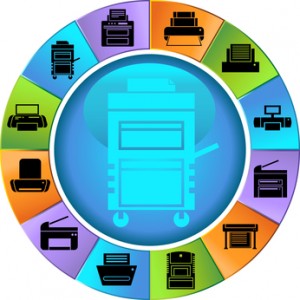 Printers are a growth industry. According to NPD Group, a Port Washington, N.Y.-based market research firm which provides data from leading technology distributors, the average selling price for a laser multi-function printer (MFP) in 2014 was $657.15. That’s a 5.4 percent increase from the year-ago average price of $623.39.
Printers are a growth industry. According to NPD Group, a Port Washington, N.Y.-based market research firm which provides data from leading technology distributors, the average selling price for a laser multi-function printer (MFP) in 2014 was $657.15. That’s a 5.4 percent increase from the year-ago average price of $623.39.
One thing that hasn’t grown is the market share held by long-time industry leader Hewlett-Packard, which saw its share of the laser multifunction printer pie drop by double-digits in 2014.
1. Hewlett-Packard
King of the hill in laser MFPs is once again Hewlett-Packard, but its share in 2014 shrunk significantly from 2013. In 2014, the company grabbed 39.4 percent of all the dollars spent through distribution on laser multifunction printers, more than 13 percentage points ahead of its nearest competitor, number-two Lexmark. But it’s still 5.8 percentage points behind its 45.2 percent share in 2013, a drop of more than 13 percent in market share. Still, the company had five of the 10 best-selling models in the U.S. last year, including its number-one LaserJet Pro 400 M425dn and third-place LaserJet Enterprise 500 M525f.
2. Lexmark
Also with two of the year’s biggest selling printers was Lexmark, which finished in second place this year with 26.3 percent of the market. Its X792dte 50-ppm color MFP was the second most popular printer in the United States last year, and its XM7155 55-ppm was the fifth-best seller. Lexmark’s share of the market grew by 1.3 percentage points to 26.3 percent share compared with 25 percent in 2013.
3. Xerox
The Xerox Work Centre line of color and monochrome MFPs offers something for every budget and business. Xerox garnered 14.4 percent of the 2014 market, an increase of 6.3 percentage points from the year-ago period, good enough for third place. Its Work Centre 7845, a 45-ppm color MFP, was the country’s fourth best-selling unit. And the 30-ppm Work Centre 7830 was an eighth-place best-seller.
4. Canon
In fourth-place is Canon, which captured 7.1 percent of the market, a drop of seven tenths of a percentage point from its 2013 share. Canon’s color MFPs and monochrome MFPs represent perhaps the most extensive lines of any of today’s vendors. Of the 10 best-selling MFPs of 2014, Canon had one, the imageCLASS MF8280Cw.
5. Brother
Capturing 5.8 percent of the U.S. market, Brother came in at number five for 2014. The company’s share in 2014 plummeted 23 percent or 1.7 percentage points compared with 2013. Among the Brother MFPs are inkjet models that can print on tabloid-sized paper starting at $199 along with a color and monochrome MFP line also priced starting at $199.
6. Samsung
At sixth place and rising fast is Samsung, the only company in the bottom half of the list to increase its market share year-over-year. Samsung’s share jumped from 3.3 percent in 2013 to 5.2 percent in 2014. That increase of 1.9 percentage points represents an improvement in Samsung’s U.S. market share of more than 64 percent. The company offers a sizeable line of color and monochromaic MFPs for small, medium and large businesses.
7. Ricoh
The seventh-place finisher in 2014 was Ricoh, which like Oki and Dell, also saw a significant reduction in its market share from the prior year. In 2013, Ricoh laser MFPs represented 1.2 percent of the total dollar volume compared with just 0.8 percent in 2014. The company divides its extensive selection of color and monochromatic MFPs into products for personal/small workgroups and models for medium/large workgroup.
8. OKI Data
OKI Data, which pioneered and dominated the office dot-matrix printer market for years, last year captured 0.6 percent of the laser MFP market, a decline of 0.6 percent from 2013 when it captured a 1.1 percent share. The company offers an extensive line of MFPs with color and monochrome output that would fit into most departmental or small-business budgets. All are based on the company’s innovative LED engine that delivers laser-like quality while using less energy.
9. Dell
Seeing its slice of the laser-multifunction pie drop year-over-year was Dell, capturing 0.5 percent of the market. The Dell laser MFP line-upincludes color and monochromatic models with wired and wireless access and other features and options to fit most every budget. The company also offers numerous consumables and supplies for VARs to generate recurring revenue.
10. Panasonic
Thought of more for ruggedized notebooks than multifunction printers, Panasonic this year captured one tenth of one percent of the lasr MFP printer market. The company offers two laser MFP models that qualify for the NPD study, one of which is billed as a multifunction copier. Panasonic’s share remained steady at 0.1 percent through 2013 and 2014.